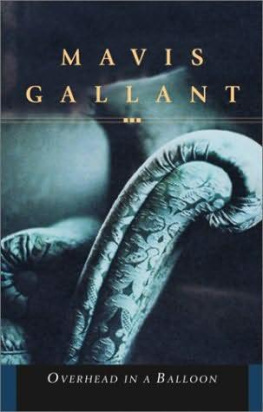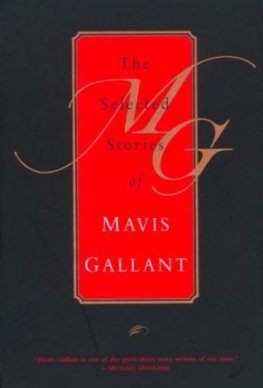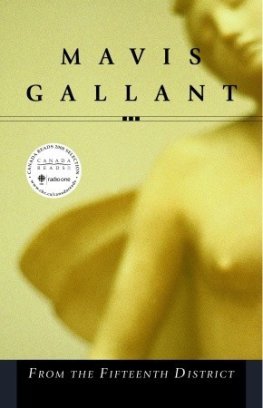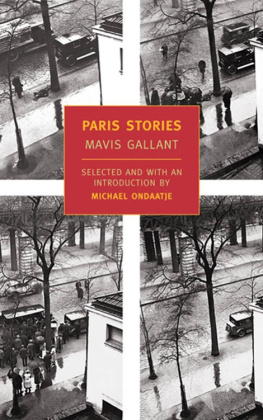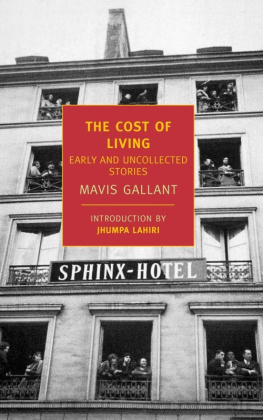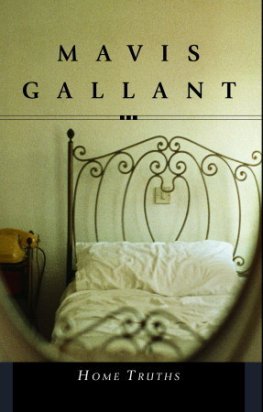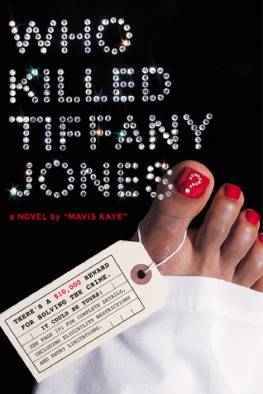Mavis Gallant - Overhead in a Balloon
Here you can read online Mavis Gallant - Overhead in a Balloon full text of the book (entire story) in english for free. Download pdf and epub, get meaning, cover and reviews about this ebook. year: 2011, publisher: McClelland & Stewart, genre: Detective and thriller. Description of the work, (preface) as well as reviews are available. Best literature library LitArk.com created for fans of good reading and offers a wide selection of genres:
Romance novel
Science fiction
Adventure
Detective
Science
History
Home and family
Prose
Art
Politics
Computer
Non-fiction
Religion
Business
Children
Humor
Choose a favorite category and find really read worthwhile books. Enjoy immersion in the world of imagination, feel the emotions of the characters or learn something new for yourself, make an fascinating discovery.
- Book:Overhead in a Balloon
- Author:
- Publisher:McClelland & Stewart
- Genre:
- Year:2011
- Rating:3 / 5
- Favourites:Add to favourites
- Your mark:
- 60
- 1
- 2
- 3
- 4
- 5
Overhead in a Balloon: summary, description and annotation
We offer to read an annotation, description, summary or preface (depends on what the author of the book "Overhead in a Balloon" wrote himself). If you haven't found the necessary information about the book — write in the comments, we will try to find it.
Overhead in a Balloon — read online for free the complete book (whole text) full work
Below is the text of the book, divided by pages. System saving the place of the last page read, allows you to conveniently read the book "Overhead in a Balloon" online for free, without having to search again every time where you left off. Put a bookmark, and you can go to the page where you finished reading at any time.
Font size:
Interval:
Bookmark:
PRAISE FOR
MAVIS GALLANTS FICTION:
Gallant is a master of montage; the overlapping angles of lives on view here hint deliciously at the full picture.
Publishers Weekly
Mavis Gallants stories are so tightly constructed, their tone so wry that they need to be digested a little at a time, like a large piece of rich cake. And its hard to leave even a bit untasted.
Newsday
Each story is a gem.
Virginia Quarterly Review
Worldly and sophisticated, worthy of lingering over, sniffing, swirling in ones mouth, tasting again and again.
Plain Dealer (Cleveland)
Mavis Gallant is a master of contemporary prose and Overhead in a Balloon is a superb and triumphant collection.
Chapel Hill Newspaper
[An] authority of presence coupled with Gallants Chekhovian eye for the intricacies of personal relationships has made Overhead in a Balloon an outstanding addition to her previous books.
Pittsburgh Press
BOOKS BY MAVIS GALLANT
DRAMA
What Is to Be Done? (1983)
ESSAYS
Paris Notebooks: Essays and Reviews (1986)
FICTION
The Other Paris (stories, 1956)
Green Water, Green Sky (novel, 1959)
My Heart Is Broken (stories, 1964)
A Fairly Good Time (novel, 1970)
The Pegnitz Junction (stories, 1973)
The End of the World (stories, 1974)
From the Fifteenth District (stories, 1979)
Home Truths (stories, 1981)
Overhead in a Balloon (stories, 1985)
In Transit (stories, 1988)
Across the Bridge (stories, 1993)
The Moslem Wife (stories, 1994)
The Selected Stories of Mavis Gallant (stories, 1996)

Copyright 1979, 1981, 1983, 1984, 1985 by Mavis Gallant
First published by Macmillan of Canada, 1985
First Emblem Editions publication 2002
All rights reserved. The use of any part of this publication reproduced, transmitted in any form or by any means, electronic, mechanical, photocopying, recording, or otherwise, or stored in a retrieval system, without the prior written consent of the publisher or, in case of photocopying or other reprographic copying, a licence from the Canadian Copyright Licensing Agency is an infringement of the copyright law.
National Library of Canada Cataloguing in Publication Data
Gallant, Mavis, 1922-
Overhead in a balloon / Mavis Gallant.
eISBN: 978-1-55199-630-1
I. Title.
PS8513.A593096 2002 C813.54 C2002-901240-6
PR9199.3.G2609 2002
We acknowledge the financial support of the Government of Canada through the Book Publishing Industry Development Program for our publishing activities. We further acknowledge the support of the Canada Council for the Arts and the Ontario Arts Council for our publishing program.
SERIES EDITOR: ELLEN SELIGMAN
EMBLEM EDITIONS
McClelland & Stewart Ltd.
The Canadian Publishers
75 Sherbourne Street
Toronto, Ontario
M5A 2P9
www.mcclelland.com/emblem
v3.1
For G. de D. M.
CONTENTS

Speck s Idea

S andor Specks first art gallery in Paris was on the Right Bank, near the Church of St. Elisabeth, on a street too narrow for cars. When his block was wiped off the map to make way for a five-story garage, Speck crossed the Seine to the shadow of Saint-Julien-le-Pauvre, where he set up shop in a picturesque slum protected by law from demolition. When this gallery was blown up by Basque separatists, who had mistaken it for a travel agency exploiting the beauty of their coast, he collected his insurance money and moved to the Faubourg Saint-Germain.
Here, at terrifying cost, he rented four excellent rooms two on the loggia level, and a clean dry basement for framing and storage. The entrance, particularly handsome, was on the street side of an eighteenth-century htel particulier built around an elegant court now let out as a parking concession. The building had long before been cut up into dirty, decaying apartments, whose spiteful, quarrelsome, and avaricious tenants were forgiven every failing by Speck for the sake of being the Count of this and the Prince of that. Like the flaking shutters, the rotting windowsills, the slops and oil stains in the ruined court, they bore a Proustian seal of distinction, like a warranty, making up for his insanely expensive lease. Though he appreciated style, he craved stability even more. In the Faubourg, he seemed at last likely to find it: not a stone could be removed without the approval of the toughest cultural authorities of the nation. Three Marxist embassies installed in former ducal mansions along the street required the presence of armed policemen the clock around. The only commercial establishments anywhere near Specks a restaurant and a bookstore seemed unlikely targets for firebombs: the first catered to lower-echelon civil servants, the second was painted royal blue, a conservative colour he found reassuring. The bookstores name, Amandine, suggested shelves of calm regional novels and accounts of travel to Imperial Russia signed A Diplomat. Pasted inside the window, flat on the pane, was an engraving that depicted an old man, bearded and mitred, tearing a small demon limb from limb. The old man looked self-conscious, the imp resigned. He supposed that this image concealed a deep religious meaning, which he did not intend to plumb. If it was holy, it was respectable; as the owner of the gallery across the street, he needed to know nothing more.
Speck was now in the parish of St. Clotilde, near enough to the church for its bells to give him migraine headache. Leaves from the church square blew as far as his door melancholy reminders of autumn, a season bad for art. (Winter was bad, too, while the first chestnut leaves unfolding heralded the worst season of all. In summer the gallery closed.) In spite of his constant proximity to churches he had remained rational. Generations of highly intellectual Central European agnostics and freethinkers had left in his bones a mistrust of the bogs and quicksands that lie beyond reality perceived. Neither loss nor grief nor guilt nor fear had ever moved him to appeal to the unknown any unknown, for there were several. Nevertheless, after signing his third lease in seven years, he decided to send Walter, his Swiss assistant, a lapsed Calvinist inching towards Rome, to light a candle at St. Clotildes. Walter paid for a five-franc taper and set it before St. Joseph, the most reliable intermediary he could find: a wave of post-conciliar puritanism seemed to have broken at St. Clotildes, sweeping away most of the mute and obliging figures to whom desires and gratitude could be expressed. Walter was willing to start again in some livelier church Notre Dame de Paris, for instance but Speck thought enough was enough.
O n a damp October evening about a year after this, there could be seen in Specks window a drawing of a woman drying her feet (Speck permanent collection); a poster announcing the current exhibition, Paris and Its Influence on the Tirana School, 1931-2; five catalogues displayed attractively; and the original of the picture on the poster a shameless copy of Foujitas Mon Intrieur re-entitled Balkan Alarm Clock. In defiance of a government circular reminding Paris galleries about the energy crisis Speck had left the lights on. This was partly to give the lie to competitors who might be putting it about that he was having money troubles. He had set the burglar alarm, bolted the security door, and was now cranking down an openwork iron screen whose Art Nouveau loops and fronds allowed the works inside to be seen but nothing larger than a mouse to get in. The faint, floating sadness he always felt while locking up had to do with the time. In his experience, love affairs and marriages perished between seven and eight oclock, the hour of rain and no taxis. All over Paris couples must be parting forever, leaving like debris along the curbs the shreds of cancelled restaurant dates, useless ballet tickets, hopeless explanations, and scraps of pride; and towards each of these disasters a taxi was pulling in, the only taxi for miles, the light on its roof already dimmed in anticipation to the twin dots that in Paris mean occupied. But occupied by whom?
Next pageFont size:
Interval:
Bookmark:
Similar books «Overhead in a Balloon»
Look at similar books to Overhead in a Balloon. We have selected literature similar in name and meaning in the hope of providing readers with more options to find new, interesting, not yet read works.
Discussion, reviews of the book Overhead in a Balloon and just readers' own opinions. Leave your comments, write what you think about the work, its meaning or the main characters. Specify what exactly you liked and what you didn't like, and why you think so.

